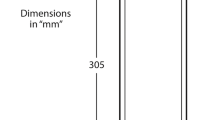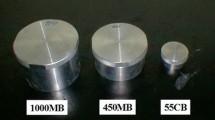Abstract
The emanation of radionuclides has been highlighted as a known source of uncertainty in the estimation of radionuclide source signatures from underground nuclear tests and other nuclear activities, particularly in the case of activation products. A system was developed at Pacific Northwest National Laboratory to quantify the emanation of argon from two powders and five rock types ranging in particle size from powder to small rocks. Samples were neutron irradiated and the percent emanation of 37Ar was measured to range between 0.3 and 25%. Measurements were also made of the 39Ar emanation for four of these materials and was found to be consistently lower than that of 37Ar.
Similar content being viewed by others
References
Haas D, Orrell J, Bowyer T, McIntyre J (2010) The science case for 37Ar as a monitor for underground nuclear explosions.
Riedmann RA, Purtschert R (2011) Natural 37Ar concentrations in soil air: implications for monitoring underground nuclear explosions. Environ Sci Technol 45:8656–8664. https://doi.org/10.1021/es201192u
McIntyre JI, Aalseth CE, Alexander TR et al (2017) Measurements of Argon-39 at the U20az underground nuclear explosion site. J Environ Radioact 178–179:28–35. https://doi.org/10.1016/j.jenvrad.2017.07.013
Johnson C, Armstrong H, Wilson WH, Biegalski SR (2015) Examination of radioargon production by cosmic neutron interactions. J Environ Radioact 140:123–129. https://doi.org/10.1016/j.jenvrad.2014.10.016
Sramek O, Stevens L, McDonough WF et al (2017) Subterranean production of neutrons, 39Ar and 21Ne: rates and uncertainties. Geochim Cosmochim Acta 196:370–387. https://doi.org/10.1016/j.gca.2016.09.040
Mei DM, Yin ZB, Spaans J et al (2010) Prediction of underground argon content for dark matter experiments. Phys Rev C - Nucl Phys 81:1–7. https://doi.org/10.1103/PhysRevC.81.055802
Fritz BG, Aalseth CE, Back HO et al (2018) Prediction of sub-surface 37 Ar concentrations at locations in the Northwestern United States. J Environ Radioact 181:1–7. https://doi.org/10.1016/j.jenvrad.2017.10.005
Lehmann BE, Davis SN, Fabryka-Martin JT (1993) Atmospheric and subsurface sources of stable and radioactive nuclides used for groundwater dating. Water Resour Res 29:2027–2040. https://doi.org/10.1029/93WR00543
Fabryka-Martin JT (1988) Production of radionuclides in the earth and their hydrogeologic significance, with emphasis on Chlorine-36 and Iodine-129. The University of Arizona
Kastlander J, Aldener M, Fritioff T et al (2019) Measurement of radioxenon and radioargon in air from soil with elevated uranium concentration. J Environ Radioact 197:62–66. https://doi.org/10.1016/j.jenvrad.2018.12.006
Sakoda A, Ishimori Y, Yamaoka K (2011) A comprehensive review of radon emanation measurements for mineral, rock, soil, mill tailing and fly ash. Appl Radiat Isot 69:1422–1435. https://doi.org/10.1016/j.apradiso.2011.06.009
Johnson C, Prinke A, Lowrey JD et al (2018) A method to quantify the37Ar emanation fraction in powders and rocks. J Radioanal Nucl Chem 318:297–303. https://doi.org/10.1007/s10967-018-6024-9
Williams RM, Aalseth CE, Brandenberger JM et al (2017) Development of a low-level 39Ar calibration standard—analysis by absolute gas counting measurements augmented with simulation. Appl Radiat Isot 126:243–248. https://doi.org/10.1016/j.apradiso.2017.02.018
Alexander TR, Aalseth CE, Back HO et al (2019) Characterization of a low background proportional counter for a high throughput Argon-37 collection and measurement system. Nucl Instrum Methods Phys Res Sect A Accel Spectr Detect Assoc Equip. https://doi.org/10.1016/j.nima.2019.01.021
Aalseth CE, Day AR, Hoppe EW et al (2009) Design and construction of a low-background, internal-source proportional counter. J Radioanal Nucl Chem 282:233–237. https://doi.org/10.1007/s10967-009-0258-5
Rearden BT, Jessee MA (2018) SCALE Code System. ORNL/TM-2005/39
Onstott TC, Miller ML, Ewing RC et al (1995) Recoil refinements: Implications for the 39Ar/40Ar dating technique. Geochim Cosmochim Acta 59:1821–1834. https://doi.org/10.1016/0016-7037(95)00085-E
Watson EB, Cherniak DJ (2003) Lattice diffusion of Ar in quartz, with constraints on Ar solubility and evidence of nanopores. Geochim Cosmochim Acta 67:2043–2062. https://doi.org/10.1016/S0016-7037(02)01340-6
Dodson MH (1973) Closure temperature in cooling geochronological and petrological systems. Contrib to Mineral Petrol 40:259–274. https://doi.org/10.1007/BF00373790
Guillon S, Sun Y, Purtschert R et al (2016) Alteration of natural 37Ar activity concentration in the subsurface by gas transport and water infiltration. J Environ Radioact 155–156:89–96. https://doi.org/10.1016/j.jenvrad.2016.02.021
Acknowledgements
The authors wish to acknowledge the National Nuclear Security Administration, Defense Nuclear Nonproliferation Research and Development, and the Underground Nuclear Explosion Signatures Experiment, a multi-year research and development project sponsored by NNSA DNN R&D and collaboratively executed by Lawrence Livermore National Laboratory, Los Alamos National Laboratory, Mission Support and Test Services, Pacific Northwest National Laboratory, and Sandia National Laboratories. The Nuclear Criticality Experiments Research Center (NCERC) is supported by the DOE Nuclear Criticality Safety Program, funded and managed by the National Nuclear Security Administration for the Department of Energy. This work was performed by Pacific Northwest National Laboratory under award number DE-AC05-76RL01830.
Author information
Authors and Affiliations
Corresponding author
Additional information
Publisher's Note
Springer Nature remains neutral with regard to jurisdictional claims in published maps and institutional affiliations.
Rights and permissions
About this article
Cite this article
Johnson, C., Lowrey, J.D., Alexander, T. et al. Measurements of the emanation of 37Ar and 39Ar from irradiated rocks and powders. J Radioanal Nucl Chem 329, 969–974 (2021). https://doi.org/10.1007/s10967-021-07827-4
Received:
Accepted:
Published:
Issue Date:
DOI: https://doi.org/10.1007/s10967-021-07827-4




